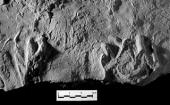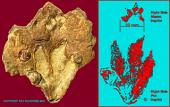 Vertebrate Traces
Vertebrate Traces
|
|
What are Vertebrate Traces? Vertebrate traces include the impressions of activities such as feeding, burrowing, resting, walking, or crawling. Vertebrates living in the water, like whales, fish, crocodiles, mosasaurs, or ichthyosaurs, only rarely leave traces in sediments; however, they may leave feeding traces on their prey. Bite marks can be found on many fossils, such as ammonites and bivalves. Terrestrial vertebrates, such as dinosaurs, birds, amphibians, snakes, and many mammals, may leave footprints, bite marks, or even evidence of what they ate in the form of fossilized dung (coprolites). The oldest definitive vertebrate trace fossils are from the Carboniferous. First known fossil occurrence: Carboniferous. Last known fossil occurrence: Quaternary. This group has living relatives. Cool Vertebrate Traces links: Search for images of Vertebrate Traces on Google |
|



